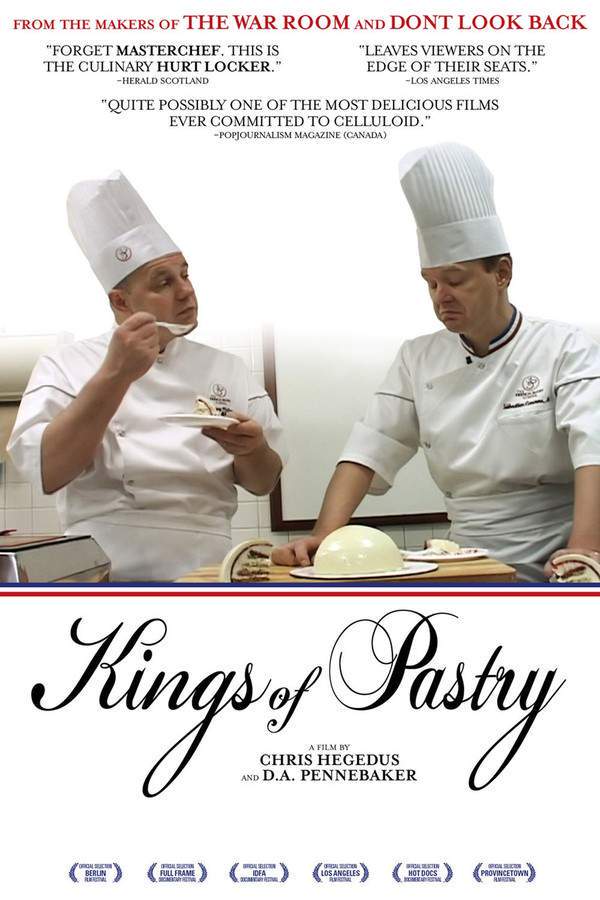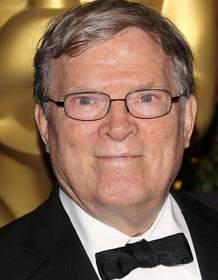Kings of Pastry 2010

Lyon, France, plays host to the prestigious Meilleurs Ouvriers de France competition, a demanding test of pastry-making expertise. Sixteen elite masters compete over three intense days, striving for the coveted blue, white, and red collar that signifies the pinnacle of their craft. The competition pushes them to their limits, impacting their finances, family relationships, and professional reputations as they pursue their lifelong dream of achieving perfection in the culinary arts.
Does Kings of Pastry have end credit scenes?
No!
Kings of Pastry does not have end credit scenes. You can leave when the credits roll.
Meet the Full Cast and Actors of Kings of Pastry
Explore the complete cast of Kings of Pastry, including both lead and supporting actors. Learn who plays each character, discover their past roles and achievements, and find out what makes this ensemble cast stand out in the world of film and television.
No actors found
External Links and Streaming Options
Discover where to watch Kings of Pastry online, including streaming platforms, rental options, and official sources. Compare reviews, ratings, and in-depth movie information across sites like IMDb, TMDb, Wikipedia or Rotten Tomatoes.
Ratings and Reviews for Kings of Pastry
See how Kings of Pastry is rated across major platforms like IMDb, Metacritic, and TMDb. Compare audience scores and critic reviews to understand where Kings of Pastry stands among top-rated movies in its genre.

69
Metascore
tbd
User Score


86%
TOMATOMETER

69%
User Score

68
%
User Score
Take the Ultimate Kings of Pastry Movie Quiz
Challenge your knowledge of Kings of Pastry with this fun and interactive movie quiz. Test yourself on key plot points, iconic characters, hidden details, and memorable moments to see how well you really know the film.
Kings of Pastry Quiz: Test your knowledge on the culinary competition and personal journeys depicted in 'Kings of Pastry'.
What is the main competition featured in the movie?
2007 French pastry competition
World Baking Championship
French Culinary Olympics
Pastry World Cup
Show hint
Full Plot Summary and Ending Explained for Kings of Pastry
Read the complete plot summary of Kings of Pastry, including all major events, twists, and the full ending explained in detail. Explore key characters, themes, hidden meanings, and everything you need to understand the story from beginning to end.
As the cinematic journey unfolds, we find ourselves at the French Pastry School in Chicago, where Jacquy Pfeiffer embarks on an exciting culinary adventure in preparation for the 2007 competition. Guided by his mentor, Chef Cannone, a former champion himself, Pfeiffer immerses in the intricate art of pastry-making. Throughout this process, he perfects an array of recipes that not only captivate with their visual presentation but also tantalize the taste buds with rich flavors. The competition’s central theme revolves around marriage, posing a creative challenge for contestants: to design an exquisite wedding buffet that showcases a variety of sweet and savory treats. This includes a grand wedding cake, an impressive chocolate sculpture, a delicate sugar creation, cream puffs, artisanal chocolate candies, breakfast pastries filled with jam, elegant tea pastries, a gourmet dessert plate, and a petite yet beautiful “bijou” to honor the occasion. The twist? Everything, except for the bijou, must be meticulously prepared from scratch and assembled in front of a discerning panel of judges over three intense days, with both presentation and flavor held in equal regard.
As Pfeiffer hones his recipes and refines his training routine, he makes a nostalgic return to his childhood home in Alsace, where he adapts his culinary creations for the particularities of French baking ingredients. He realizes that differences in ingredients between France and the U.S. can radically alter the texture and flavor of his pastries. For instance, French butter has a richer fat content and less water, demanding precise adjustments to avoid baking mishaps. Although Pfeiffer prepares for these ingredient variations, the pressure of time constraints forces him to make last-minute changes to his wedding cake and sugar sculpture just before the competition commences.
Introducing two more talented pastry chefs, we have Regis Lazard, who is mentored by the distinguished pastry chef of French President Nicolas Sarkozy, and Philippe Rigollot, renowned for his role at the prestigious Maison Pic’s Valence restaurant—an establishment boasting three Michelin stars and owned by a woman. This marks Rigollot’s competitive debut, while Lazard is returning for his second attempt. After the 2007 contest, Rigollot ultimately opens his own pâtisserie, Pâtisserie Philippe Rigollot, located in Annecy, thereby solidifying his esteemed reputation.
As anticipation builds, the climactic finale takes place in Lyon, where the sixteen distinguished finalists come together to demonstrate their culinary expertise. Over three extremely demanding days, these chefs meticulously create their buffets under the watchful eyes of revered judges, including pastry legends Jacques Torres, Pascal Niau, and Pierre Herme. With their reputations at stake, each contestant must balance their artistic vision with flawless technical execution to captivate the judges’ refined palates. The scrutiny is intense; every detail is analyzed—from the cleanliness of their setups to the organization of their workspaces and waste disposal. The mounting pressure inevitably weighs on the competitors, whose nervous energy simmers beneath the surface like a rich sauce on the brink of boiling over.
As the final deadline creeps closer, the tension becomes almost suffocating. A poignant moment occurs when Rigollot’s ornate sugar sculpture—the centerpiece of his buffet—collapses in the kitchen, leaving him devastated and the MOF judges visibly affected by his misfortune. However, he remains resolute and earns the coveted MOF title through extraordinary performances in other categories. Meanwhile, Jacquy Pfeiffer’s aspirations for culinary excellence face a temporary pause as he reassesses his approach and decides to marry his sweetheart. The future looks rather uncertain for Regis Lazard, however.
In a surprising turn of events, Pfeiffer decides not to retake the exam in 2011, marking a pivotal moment in his culinary journey. Despite this significant choice, the ambitions of these fervent chefs never wane; they must continue navigating the dynamic landscape of their culinary careers, driven by renewed determination and purpose.
Uncover the Details: Timeline, Characters, Themes, and Beyond!

Coming soon on iOS and Android
The Plot Explained Mobile App
From blockbusters to hidden gems — dive into movie stories anytime, anywhere. Save your favorites, discover plots faster, and never miss a twist again.
Sign up to be the first to know when we launch. Your email stays private — always.
Watch Trailers, Clips & Behind-the-Scenes for Kings of Pastry
Watch official trailers, exclusive clips, cast interviews, and behind-the-scenes footage from Kings of Pastry. Dive deeper into the making of the film, its standout moments, and key production insights.
Kings of Pastry Other Names and Titles
Explore the various alternative titles, translations, and other names used for Kings of Pastry across different regions and languages. Understand how the film is marketed and recognized worldwide.
Quick Links: Summary, Cast, Ratings, More

What's After the Movie?
Not sure whether to stay after the credits? Find out!
Explore Our Movie Platform
New Movie Releases (2025)
Famous Movie Actors
Top Film Production Studios
Movie Plot Summaries & Endings
Major Movie Awards & Winners
Best Concert Films & Music Documentaries
Movie Collections and Curated Lists
© 2025 What's After the Movie. All rights reserved.

















